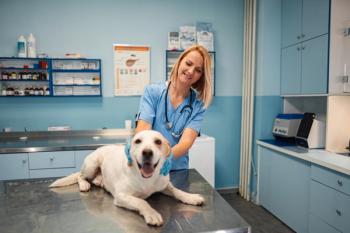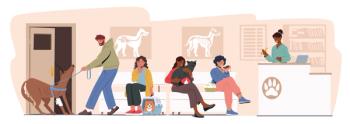
Fear-Free veterinary visit tip: Just breathe!
A calmer client means a calmer pet.
You do it every day. In fact, you're doing it right now. But are you doing it right? And could you help pets, their owners-and yourself-stay calmer with simple changes in breathing?
A case for deep breathing
Deep breathing can decrease stress and promote feelings of calm. It releases tension and promotes wellbeing over mind and body, lowering heart rate and blood pressure. Taking deeper breaths turns on the body's parasympathetic nervous system that counters the fight-or-flight response and slows down the body when it's stressed. When you take deep breaths the vagus nerve releases a neurotransmitter, acetylcholine, that decreases anxiety while promoting feelings of calm and increased focus. It also reduces stress hormones, including cortisol, and boosts feel-good hormones like oxytocin and prolactin. And the extra flow of oxygen provides an energy boost and releases endorphins that improve mood and relieve pain.
Images courtesy of Getty Images
Calm person, calm pet
Many times stress causes changes in body language, such as hand wringing or muscle tenseness and shallow breathing. In the veterinary environment, not only will clients and coworkers notice these physical changes-animals may notice too. Animals may perceive this anxiety and tension as a signal of a threat and imminent danger. As an animal trainer, I've noticed dogs appearing upset and reacting when their person becomes anxious-holding their breath and tightening the leash, for example. The dog may begin to bark and lunge simply because they correlate their owner's stress to negative events occurring.
For example, when you're about to give an injection you may notice the client hovering over the dog, using anxious talk in an attempt to soothe or grimacing and looking away. And the animal may react defensively or fearfully in response before any treatment even takes place. So the person's reaction, including breathing that promotes an overall feeling of calm, can lower everyone's stress level.
Learn it, use it and teach it to team members and clients
Taking deep breaths reduces anxiety and stress and presents a calmer, more confident presence to people and animals alike.
How do you take these deep breaths?
> Breathe in through your nose on the slow count of three and hold the breath just for a moment.
> Breathe out slowly through a slightly opened mouth, counting to three again. Continue until you feel your body relaxing. Many times deep breathing for a minute or for a repetition of three to six breaths can create the feelings of relaxation.
> Take deep breaths. Most breathing is shallow and only uses part of the lungs. You can feel the deeper breaths by placing a hand on the belly and feeling the stomach extend and contract with each breath and exhalation.
> Focus on sitting or standing upright so you use your full lung capacity.
Now teach Trixie or Fido
Now let's combine our own deep breaths with the deep breathing exercises we can teach to dogs. Animals also have stress patterns related to their breathing. Fluid, regular breaths are associated with a relaxed animal, while shallow and rapid breaths-like stress panting or holding their breath-are associated with anxiety and fight-or-flight reactions. One of the foundational behaviors I teach dogs is to give focused attention while breathing deeply.
The animal is asked to do a relaxed position, like a down or a sit with eye contact while paying special attention to rewarding the animal for keeping their mouth closed. The closed mouth causes the animal to breathe in through the nose, making the breaths deeper and-just as in people-slowing down heart rate and blood pressure and promoting calm.
When the pet and the guardian are entering a stressful environment, such as a veterinary visit, invite clients to use deep breathing while they simultaneously guide and reward their dog for doing the same with attention exercises. Many times, after only a minute or two, both the animal and person are more relaxed.
Practice together
Even without teaching, some animals respond immediately to people who practice calming breaths. Right now as I'm writing this I have my pug, Willy, on my lap. As I take these deep breaths intentionally while writing, I can feel his own breathing slowing down to meet with my own. He's even letting out little sighs of relaxation as he nestles in deeper on my lap. The change in breathing because of my own is very noticeable, with my other pug doing deep sighs nearly immediately after my own when I focus on a long exhalation at the end of each breathing session. For those dogs that are especially connected to their people, the transfer of calming breaths can take place naturally.
When can you use deep breathing?
It's so subtle, it can be embraced without being perceptible while you engage in a conversation or while the other person is talking. Or you can use it just before entering the exam room. When an animal is stressed, take a few moments to decompress yourself and release stress through deep breathing, and invite the client to do the same. And sometimes the momentary pause and release of anxiety can be enough to calm down the situation enough to be safe to proceed with the exam or procedure.
Newsletter
From exam room tips to practice management insights, get trusted veterinary news delivered straight to your inbox—subscribe to dvm360.






